Taking your ebike with you on an RV trip is great, but do you know how to charge your bike when camping? Whether you’re headed to a campground or your favorite backcountry secret camping spot, there are many ways to charge an ebike while camping.
Let’s look at how to charge an ebike while camping and how often you’ll need to do so. Plus, all the best ways to charge your ebike and helpful tips to maximize your ebike’s battery life.
How Often Will You Need to Charge an EBike While Camping?

Your best bet is to charge an ebike after every ride, whether you’re camping or not. At the very least, you should charge your ebike once it drops to about 30% charge. Many sources recommend alternating between charging at 30% battery and charging at 60% battery, as this maximizes the battery’s lifespan.
The 8 Best Ways to Charge Your eBike While Camping

There are a variety of ways to charge your ebike while camping. Overall, you can use the same power sources you’d use for other cordless devices to charge your bike. Let’s look at the 8 best ways to charge your ebike.
1. Electrical Outlets at Campgrounds Can Charge eBikes While Camping

Probably the simplest way to charge an ebike while RVing is to plug it into shore power. If you use an electrical outlet at a campground, you don’t have to worry about your RV battery levels, setting up charging equipment, or anything of the sort. Just plug it in, and you’re good to go.
2. Bring an Extra Battery Bank to Charge an eBike While Camping
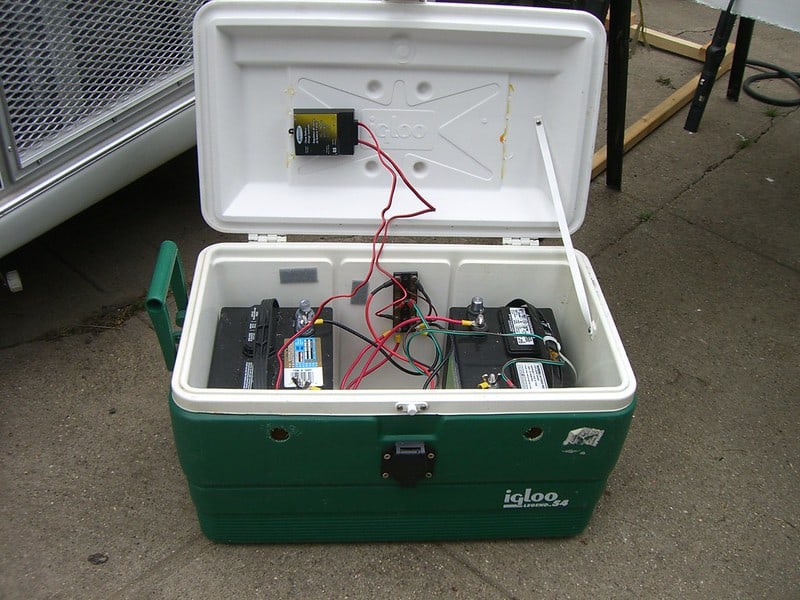
An extra battery bank will provide you with an extra store of power to charge your ebike with.
Building a separate battery bank is a relatively simple project requiring a few tools. You could also simply expand your existing RV battery bank to offset the power your ebike uses while it’s juicing up.
3. Solar Panels Can Charge eBikes While Camping

Solar panels are an eco-friendly way to charge your electrical bike. You can set up a solar panel to charge the bike directly or use the panel to charge a battery, which you then use to charge the bike.
4. Generators Are Great to Charge eBikes While Camping

Both traditional gas generators and solar generators (AKA “portable power stations”) can be used to charge your ebike when you go RVing. Simply plug the bike into your generator and run it for a few hours until its battery is full.
5. Car Batteries Will Charge eBikes When Camping
You can plug your ebike into a passenger car battery to charge the bike. Some minivans and SUVs have inverted AC 110v outlets built-in.
Many ebikes come with AC to DC chargers (the black box attached to the charging cord). Ebikes use DC power, so you can buy a DC charger (the circular cigarette lighter plug) to charge your Ebike instead.
Using your passenger car’s battery isn’t ideal since it will run down your vehicle’s battery. It isn’t the fastest method either. But it will work in a pinch.
6. RV Battery Inverters Can Handle Charging eBikes While Camping
Your RV battery inverter works similarly to your car’s battery inverter, taking DC power from your house batteries and converting it to AC power to charge the bike. Using your RV’s batteries is much better than using your car’s.
RV battery banks can supply much more power and are made to handle this type of power drain. Simply plug your ebike charger into your camp side electrical outlet and wait until they’re at full power.
7. Charge Your eBike When Camping and Riding
Some ebikes use technology that recharges the batteries while pedaling and/or braking. There’s also aftermarket portable charging equipment available that uses technologies like solar to recharge your bike while in motion.
Some ebike riders even build their own solar trailers to keep the bike charging while they ride.
8. Find an Ebike Charging Station If Possible
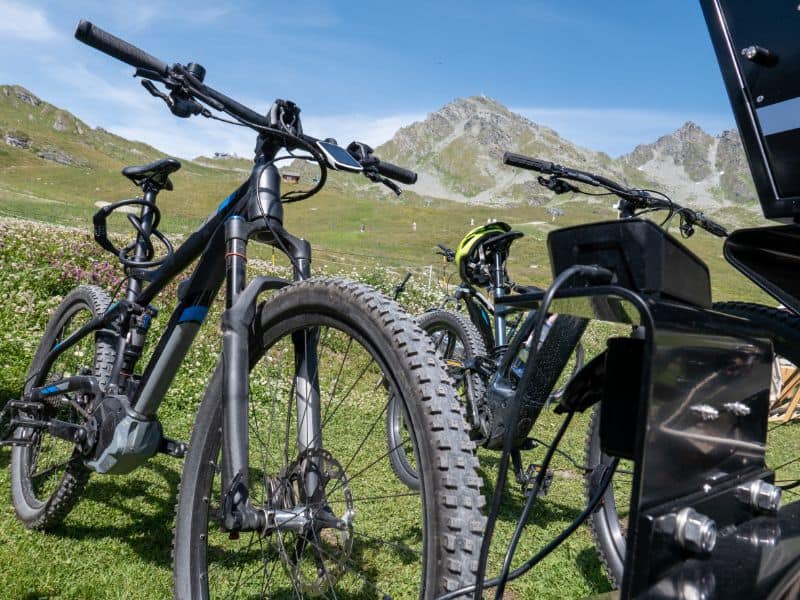
Charging stations made specifically for ebikes can be found dotted around the country (particularly on the west coast). In some cases, charging stations for electric vehicles are also outfitted to charge electrical bikes.
What You Should Know About Charging an Ebike Before Finding a Power Source

Regardless of what power source you use, there are a few things to know about charging your ebike while camping:
- Use the provided charger (or an approved alternative) to charge your bike, avoiding battery issues.
- Ensure the bike is powered off before charging.
- Charge the bike inside or somewhere where it’s covered and protected from the elements.
- Keep a charging bike away from anything flammable, like a propane tank.
- To be safe, only use bikes whose chargers and batteries carry a UL-2849 stamp. This indicates the bike’s electrical systems meet all relevant safety standards.
How Much Power Do You Need to Charge Your Ebike?

The amount of power you’ll need to charge your ebike depends on its electrical system. Lightweight ebikes typically need 400 to 500 watt-hours for a charge. Bigger, more powerful ebikes typically need 500 to 800 watt-hours.
To find the wattage of your ebike, you can multiply the voltage of the battery by the amperage of the controller. For example, a 36-volt ebike battery with a 15-amp controller will have a battery wattage of 540 watts.
Volts x Amperage (Amps) = Wattage (Watts)
Should You Leave Your Ebike Battery Plugged In?

You can leave most ebikes plugged in and charging for extended periods without any worries. Your ebike electrical system automatically stops charging when the battery is full.
However, if your ebike stays plugged in after it’s done charging, it will slowly “leak” charge. So it’s best to unplug your bike once it’s full.
Does the Type of Ebike Battery Matter for Charging?
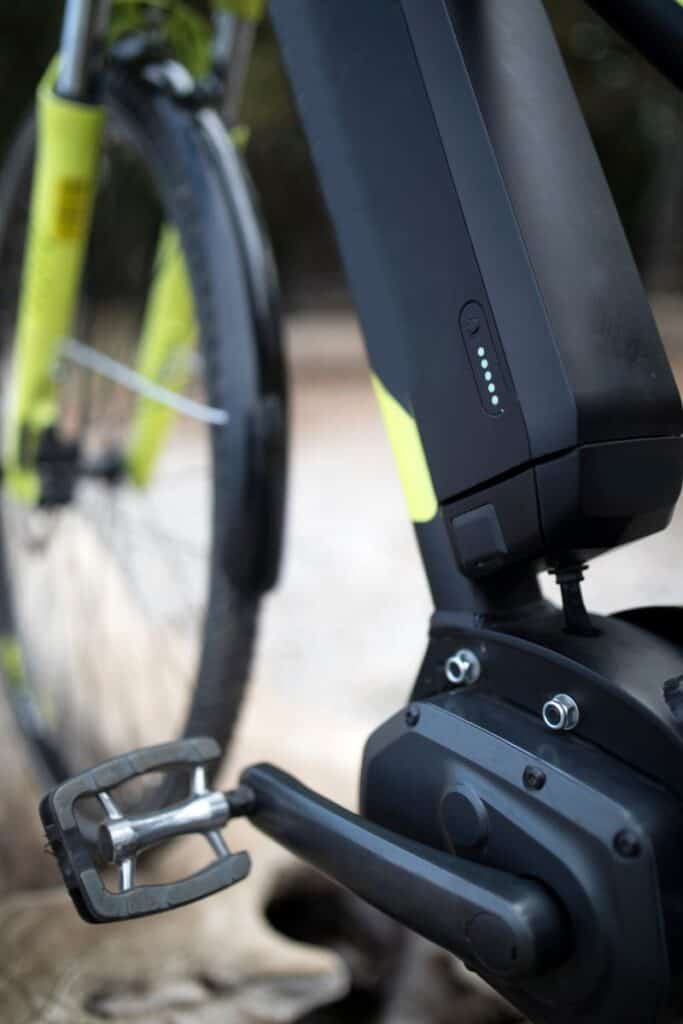
Most ebikes have lithium-ion batteries, but you’ll occasionally find bikes with other battery chemistries – like lead acid. Overall, the battery type won’t affect charging much, although lithium-ion batteries will charge more efficiently than other types.
Non-lithium batteries will also need to be charged sooner since they can’t be discharged as much as lithium batteries can.
You may have heard in the past that you should let a battery discharge fully before charging it. This is due to something called “battery memory,” where a battery’s total capacity drops if the battery is recharged before discharging fully to 0%.
Thankfully, the memory effect only applies to nickel-cadmium batteries, which aren’t typically used in ebikes.
How Much Ebike Battery Power Do You Need for Camping?
The amount of power you’ll need to charge your ebike battery while camping depends on the exact bike and how you’ll use it. Most bikes need somewhere between 500 and 800 watt-hours for a full charge.
11 Ways to Make Your Ebike Battery Last Longer
Following a few guidelines can help maximize your ebike’s battery life. Here are 11 ways to make your ebike battery last longer, so you can spend less time charging and more time riding.
1. Maintain It Properly

Properly maintaining your electrical bike will improve your bike’s efficiency, helping the battery last longer. Keep the bike clean and lubed up, and replace parts like brakes and chains when they get worn out.
Also, you should never store your battery in a completely discharged state for long periods. If your battery is going into storage, make sure it has a charge first.
2. Don’t Overcharge It
Overcharging a lithium battery is very dangerous. Thankfully, most ebikes will come with a charge controller that automatically prevents overcharging. However, if your ebike doesn’t have that, be sure to unplug it once it’s fully charged to prevent any issues.
3. Don’t Undercharge It
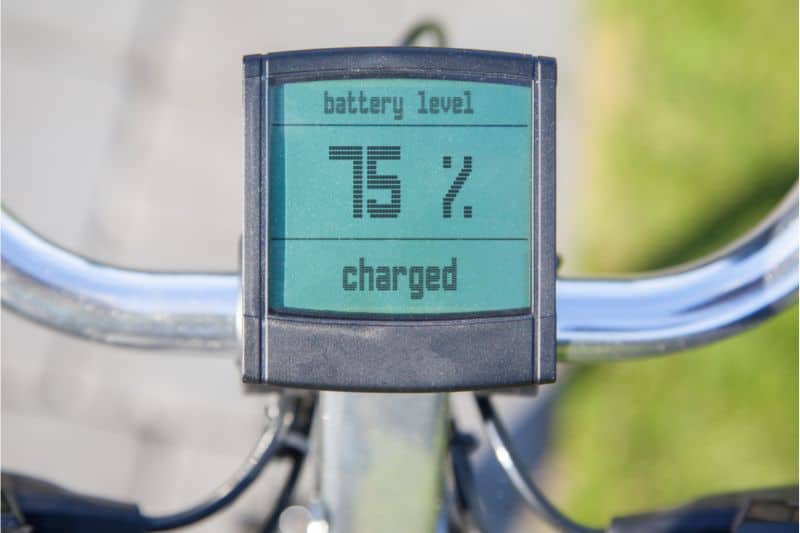
Too low of a charge can be bad for your ebike battery too. It’s advisable to charge your bike to at least 80% or so whenever you charge it.
4. Reduce the Weight
The heavier your ebike, the harder the battery has to work. To increase efficiency and battery life, try to remove any extra weight before heading out. The easiest way to cut weight is to remove anything you don’t need from your backpack and/or pannier.
5. Aim for Smoother Terrain
Smoother terrain is easier on your ebike and, thus, strains the battery less. Avoid rough and rocky terrain as much as you can.
6. Store the Bike and Battery Properly
When not in use, store your ebike and battery out of the sun in a relatively cool location. Be sure to keep it out of the elements. If it has to be outside for extended periods, at least cover it up.
7. Use Ebike Modes Efficiently
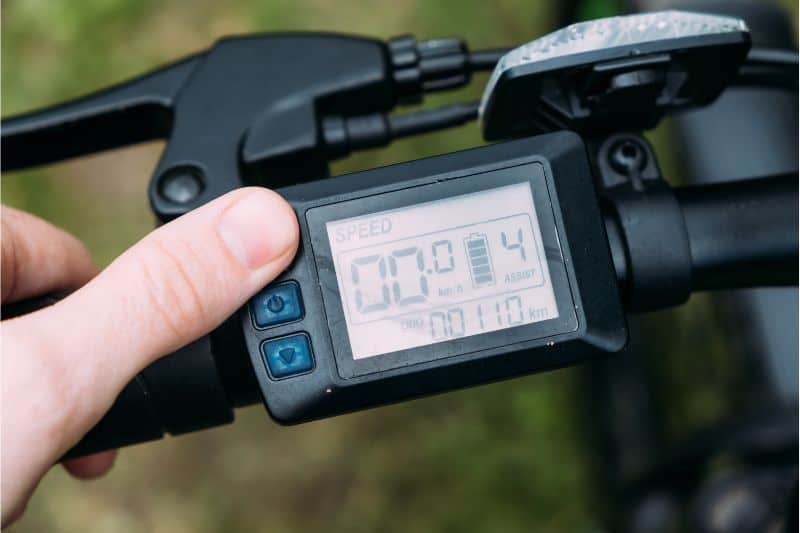
Ebikes have different modes for different uses, and the exact modes will depend on your bike. Generally, an ebike will have a high-efficiency “eco” mode and at least one more powerful “boost” or “power” mode. These latter modes give you more power but require more energy from the battery.
To help your battery last longer, avoid overusing your high-powered mode and stick to eco mode as much as possible.
8. Pedal Smoothly
Pedaling with a smooth, consistent cadence lets your battery provide more consistent power and better assist you. This helps prevent large spikes in power, allowing the battery to last longer.
9. Fully Charge the Battery

Leaving your ebike with a low charge for an extended period can be bad for the battery. Be sure to charge your ebike between uses fully. This gives you the maximum battery life possible and maintains your battery health.
10. Practice Safe Charging
Unsafe charging practices can damage your ebike battery and reduce the maximum charge. Always use the provided charger (or an approved replacement) to charge it, and never try to charge a bike with a damaged battery.
11. Avoid Extreme Temperatures
Extreme temperatures can have a negative effect on your ebike batteries. Avoid storing your bike in extreme heat or cold; never charge the batteries when temperatures are below freezing.
Final Thoughts on Where to Charge an Ebike While Camping

Charging an ebike while camping is easy and not too different from charging your favorite gadgets. You can charge an ebike using the same power sources you’d use for anything else, like shore power hookups at campsites, gas generators, or solar panels.
To maximize your ebike’s battery life, you should avoid over or undercharging the battery. To keep your bike running, maintain your bike and battery, store them properly, and keep your bike out of extreme temperatures. To get the most out of a single charge, pedal smoothly and avoid rough terrain when possible.
About the author:
Jennifer Jennings is a full-time RVer and part-time van lifer. She is one half of DashboardDrifters.com and the founder of RVSpotDrop, a web service for full-time RVers.




